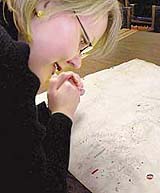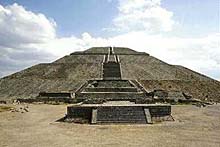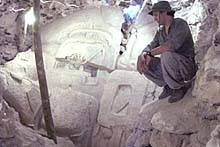|
|


Editorial
|
Press Releases
|
Book Reviews
|
Fragments
NEW! Artifacts: Coral Castle
Grand Canyon II
|
Giants IV
|
Osiria IV
Register
for our Hall of Records Newsletter!
Questions? Comments? Suggestions? Advertising? Press Releases?
Contact us!
Ancient Map
|
Pharaoh's Helicopter
|
Teotihuacan
|
Mayan Mysteries
|
Books


Carol Urness, curator emeritus at the James Ford Bell Library at the University of Minnesota, examines the controversial "Pizzigano
map", a navigational map hand-painted on a piece of animal skin in 1424 by Venetian cartographer Zuane Pizzigano.
British author Gavin Menziesa, in his book
1421: The Year China Discovered America
argues that the map is evidence that the ancient Chinese had explored and mapped out the Americas nearly a century before Columbus. The
Pizzigano map
is currently on display at
The James Ford Bell Library
in Minneapolis, Minnesota.
|
|
On February 2, 1421, Chinese emperor Zhu Di celebrated New Year's Day accompanied by no less than 28 heads of state from nations from all around the world. This day was particulary special, as Zhu Dhi was inaugurating the completion of his new, capitol city in Beijing, the mysterious "Forbidden City", and these heads of state had been brought to bear witness to its glory.
So great was the power of Zhu Di and of China, which at that time was the largest and most advanced empire in the world, that the Holy Roman Emperor, the Emperor of Byzantium, the Doge of Venice, and even the kings of England, France, Spain and Portugal had not been invited to the ceremony. This was due to the fact that, even though these countries were relatively civilized, in comparison with the exceptional power and technological advancement of China under Emperor Zhu Di, they had been deemed too primitive and backward to be considered worthy of invitation.
Perhaps the most interesting feature of this story is the fact that the Chinese emperor had brought all of these heads of state from around the world to China via his vast fleet of ships. According to ancient Chinese history, this fleet of ships had been commanded by Emperor Zhu Di's "eunuch admirals".
Gavin Menzies, in his book
1421: The Year China Discovered America,
believes that these eunuch admirals had charted most if not all of the globe, including the Americas.
As evidence he cites an ancient map found in the collection of the University of Minnesota's
James Ford Bell Library,
drawn in 1424 by Venetian cartographer Zuane Pizzigano, that he believes had been copied from a Chinese original. He further argues that Chinese treasure fleets had made voyages as early as the 15th century to the Americas, as well as Greenland, Antarctica, Australia and New Zealand, but that most of the records had been destroyed by court officials when China's foreign policy turned inward and contacts with the outside world were cut off, the Pizzigano map being a copy of the few records to survive the purge. If true, Menzies' theory may be the last nail in the coffin of the
isolationist
method of interpreting ancient American history, and may force us to revise our dating of the discovery of America.
The University of Minnesota's
James Ford Bell library, 472 Wilson Library, 309 19th Avenue South, Minneapolis, Minnesota 55455 is open to visitors during the summer (May 27 - Sept 1) Monday through Friday, 12:30 p.m. to 4:30 p.m. Phone: (612) 624-1528. Call ahead at other times for permission.



 Ancient Map at Core of New Debate
Ancient Map at Core of New Debate
 James Ford Bell Library: Pizzigano Map
James Ford Bell Library: Pizzigano Map
 HarperCollins.com: 1421: The Year China Discovered America (excerpt)
HarperCollins.com: 1421: The Year China Discovered America (excerpt)
 Cheng Zu, Zhu Di, 1403-1424,
Cheng Zu, Zhu Di, 1403-1424,
Emperor Ming Dynasty
 Asian Historical Architecture:
Asian Historical Architecture:
The Forbidden City
 Ming Tombs: The Thirteen Tombs, ShisanLing
Ming Tombs: The Thirteen Tombs, ShisanLing
 China National Tourism Association
China National Tourism Association
 Travel China Guide
Travel China Guide
 China Travel Service
China Travel Service
 BeijingTrip.com
BeijingTrip.com
 Imperial Tours
Imperial Tours
 China Today
China Today
|
|
|
|


 The infamous "Pharaoh's Helicopter" hieroglyph in the Temple of Osiris in Abydos, Egypt. Many have believed that the above
hieroglyphs, particularly the "helicopter" (shown enhanced at bottom) are evidence of ancient technology, academic Egyptologists
have pointed out that it is more likely a "palimpsest", a writing tablet, papyrus, or stone that has been reused, with previous
writing still showing through.
Image from
Catchpenny Mysteries.
The infamous "Pharaoh's Helicopter" hieroglyph in the Temple of Osiris in Abydos, Egypt. Many have believed that the above
hieroglyphs, particularly the "helicopter" (shown enhanced at bottom) are evidence of ancient technology, academic Egyptologists
have pointed out that it is more likely a "palimpsest", a writing tablet, papyrus, or stone that has been reused, with previous
writing still showing through.
Image from
Catchpenny Mysteries.
|
|
Though we have covered many of the ancient technological artifacts of ancient Egypt in Part II of our
Ah, Osiria!
series, many more technological artifacts and carved stones recalling the world from before the Flood still remain, waiting to
be found and properly interpreted. One of these is the infamous "Pharaoh's Helicopter", found some years back by intrepid,
independent researchers in the
Temple of Osiris
in
Abydos,
Egypt.
The infamous photo of this "wall of eternity" made its rounds 'round the Net in the late 90s, first and most conspicuously
popularized by Amargi Hillier in his gone, but not forgotten, "Project Duat" site (http://www.projectduat.com). The images show
not only what some believe to be a helicopter (top left), a submarine (top right, note the trailing "snorkel"), and an airplane
(middle right) dropping a bomb on a "landspeeder"-type surface craft (bottom right).
The helicopter hieroglyph was then further popularized by Richard C. Hoaglund, of the
Enterprise Mission,
who encouraged FOX to do an investigation of the mysterious glyphs. The resulting footage was then aired on March 2nd, 1999.
Hoaglund, though not the discoverer of the glyphs, also pointed out that the bottom right glyph did in fact look much like the
"landspeeder" used in the original Star Wars film.
More recently, however, academics have dismissed the "Pharaoh's Helicopter" concept, explaining that the current hieroglyphics
are in fact a "palimpsest" — that is, previous carvings that had been ground down or plastered are still
visible, the old writing combined with new writing to form what appears to be figures of helicopters and other exotic craft.
Though this does seem the most likely explanation, Egyptologists are unable to satisfactorily reconstruct the supposed
original writing. And though the above image was doctored slightly, the helicopter-like image is still clearly visible on the
original.
Interestingly, in the Kebra Negast, King Solomon was said to have visited the Queen of Sheba in a flying ship. Perhaps he,
as we are now beginning to understand more and more, was right when he said, "there is nothing new under the sun."
"Pharaoh's Helicopter" can be found in the Temple of Osiris in Abydos, Egypt, though your tour guide will
likely not refer to it as such. For more information on
visiting Abydos
and countless other fascinating and mysterious sites around Egypt, contact
TourEgypt.net
or
Travel Egypt.



 Catchpenny Mysteries: Pharaoh's Helicopter?
Catchpenny Mysteries: Pharaoh's Helicopter?
 The Abydos temple helicopter
The Abydos temple helicopter
 The Abydos-Hieroglyph does NOT depict a Helicopter
The Abydos-Hieroglyph does NOT depict a Helicopter
 Knights Templar: Ancient Aircraft
Knights Templar: Ancient Aircraft
 Opening the Tombs - The Abydos Glyph
Opening the Tombs - The Abydos Glyph
 "Opening The Lost Tombs...": The Enterprise Discovery
"Opening The Lost Tombs...": The Enterprise Discovery
 Enterprise Mission: The "Lost Tombs" Revisited
Enterprise Mission: The "Lost Tombs" Revisited
 TourEgypt: The Temple of Osiris and the Other Temples of Abydos
TourEgypt: The Temple of Osiris and the Other Temples of Abydos
 Abydos: Holy City of Ancient Egypt
Abydos: Holy City of Ancient Egypt
 Abydos: Virtual Tour
Abydos: Virtual Tour
 Abydos: Puzzle
Abydos: Puzzle
 About.com: Egypt Travel Planner
About.com: Egypt Travel Planner
 Tour Egypt: Abydos
Tour Egypt: Abydos
 Travel Egypt
Travel Egypt
|
|

|


The Pyramid of the Sun.
The Pyramid of the Sun is the largest of Teotihuacan's numerous pyramids, all of which are lined up along a broad concourse known as
The Avenue of the Dead.
During its peak, Teotihuacan was the sixth most populous city in the world.
|
|
Recently, scientists from Mexico's National Autonomous University have begun to use a new method of seeing through the countless
courses of immense stones that make up Teotihuacan's
Pyramid of the Sun, built during the 2nd century b.c. by a people still unknown.
The device they used was a particle detector rigged to detect "muons", tiny radioactive particles from outer space that can penetrate
not only through Earth's atmosphere, but through the massive layers of rock that make up the Pyramid of the Sun. Dragging this device
down the known corridors of the pyramid, they hope that hidden passages and crypts will reveal themselves as variations in the number
of muons that pass through the pyramid. More muons in some spots means that those spots contain empty air instead of stone and, thus
possible hidden rooms and passages.
Unfortunately for the researchers, the walk down down the corridor is a humid, cramped passageway that is over 300 feet long. Moreover,
the detector will only be able to see rooms and passageways that are directly above the detector, greatly limiting the area of the
pyramid that will be searchable. On the positive side, the procedure is relatively easy compared to drilling, and totally non-destructive, making it ideal for archaeological work. If passages are found, of course, some destruction will be necessary, but any
destruction will more than likely be offset by the wealth of archaeological treasures that might be uncovered.
Back in 1998, a secret burial chamber was found within the nearby
Pyramid of the Moon,
which sits at the north end of the Avenue of the Dead. It was the tomb of an adult male who had apparently been sacrificed, and
accompanied in death with over 150 artifacts, including obsidian and greenstone figurines, obsidian tools, pyrite mirrors, and
several types of shells, as well as the remains of several hawks and two jaguars, which may have been buried alive with him. With
this sort of find waiting to be uncovered, it is no wonder that the scientists from Mexico's National Autonomous University spent over
$500,000 on their highly specialized equipment. Hopefully, their investment will pay off.
Teotihuacan is located in the heartland of Mexico, in the central section of the Valley of Teotihuacan. Mexico is a popular tourist
destination, especially for those in North America, as it has many excellent resorts and superb and highly accessible archaeological
sites such as Teotihuacan (but don't drink the water). Check out
Mexico.com
to plan your Mexican vacation today!



 BBC News: Physicists Probe ancient pyramid
BBC News: Physicists Probe ancient pyramid
 Archaeology: New Tomb at Teotihuacan
Archaeology: New Tomb at Teotihuacan
 Location of Teotihuacan in Mexico
Location of Teotihuacan in Mexico
 Teotihuacan.com
Teotihuacan.com
 Arizona State University: Teotihuacan City of the Gods
Arizona State University: Teotihuacan City of the Gods
 Tulane University: Teotihuacan
Tulane University: Teotihuacan
 MexicoCity.com: Teotihuacan
MexicoCity.com: Teotihuacan
 Teotihuacan: City of the Gods
Teotihuacan: City of the Gods
 The Metropolitan Museum: Teotihuacan
The Metropolitan Museum: Teotihuacan
 Hillman Wonders of the World: Teotihuacan
Hillman Wonders of the World: Teotihuacan
 Mexico.com
Mexico.com
 Si-Mexico
Si-Mexico
 Know Mexico
Know Mexico
 Andale Mexico
Andale Mexico
 Mexico Online
Mexico Online
 Traveler's Health: Central America
Traveler's Health: Central America
|
|
|
|

 The giant head of an ancient Maya deity, found in a pyramid complex in Civel, Guatemala. First discovered in 1984, more recent
excavations since 2001 have uncovered a "pre-Classic" Maya civilization that was more advanced than the "Classic Period" Mayans.
Image from
BBC News
.
The giant head of an ancient Maya deity, found in a pyramid complex in Civel, Guatemala. First discovered in 1984, more recent
excavations since 2001 have uncovered a "pre-Classic" Maya civilization that was more advanced than the "Classic Period" Mayans.
Image from
BBC News
.
|
|
In 1984, explorer Ian Graham of the Corpus of Maya Hieroglyphics Project discovered the ancient Mayan city of Cival, in Guatemala's
Peten region, in northern Guatemala near the border with Mexico. In 2004, a National Geographic expedition, led by archaeologist
Francisco Estrada-Belli, has been undertaken to better understand this once-hidden jungle enigma.
Estrada-Belli has dated Cival to as early as 200 b.c., which places it during the earlier, "pre-Classic" period of Mayan history.
It was
one of the largest cities of that period, housing 10,000 people or more during its peak. Moreover, belying its "pre-Classic"
status, Cival displays some very advanced features, such as the fact that the central axis of the main buildings and plaza
are oriented to the equinoctial sunrise, when the sun is at its midpoint in the spring and the fall.
This fact, along with
the fact that the Maya of the city-state of Cival already had many of the features that had previously been considered exclusive
to the Classic Period, such as kingship, complex iconography, elaborate palaces and burials, has led scientists to conclude that
the pre-Classic Mayans may have been more advanced than previously thought. This is yet more evidence against the uniformitarian
theory of human civilization, which posited that cultures always develop from primitive cultures to civilized ones.
The most interesting recent find was the discovery of numerous jade artifacts, as well as some colossal stone heads that had
previously been buried. The colossal stone carved masks were found when, exploring around the base of one of the pyramids,
Estrada-Belli came upon a looter's tunnel. When exploring the tunnel, Estrada-Belli came upon some carved stucco masonry that
he had discovered by reaching through a fissure in the wall. Upon uncovering the masonry, Estrada-Belli discovered two giant stone
masks of ancient Mayan deities. Upon further analysis, the deities appeared to be corn gods, as the eyes are adorned with corn
husks. Adding to the mystery is the fact that the giant stone faces also display a fierce mouth replete with fangs.
Guatemala lies at the heart of the ancient Mayan empire, which stretched well into what is now Mexico, particularly the Yucatan
Peninsula. Though Guatemala is a beautiful country and relatively peaceful, some areas do have problems with crime, and travelers
are adviced to travel only as part of a tour group. Moreover, due to the excavation, access to Cival may be limited, but there is
no shortage of other Mayan sites to see, either in Guatemala or nearby Mexico.



 Maya Culture 'Ahead of Its Time'
Maya Culture 'Ahead of Its Time'
 Mesoweb: Cival: A Preclassic Maya Site in the News
Mesoweb: Cival: A Preclassic Maya Site in the News
 Culture Kiosque: Preclassic Maya City Discovered in Guatemala
Culture Kiosque: Preclassic Maya City Discovered in Guatemala
 TutorGig: Cival: Major Maya findings at Cival
TutorGig: Cival: Major Maya findings at Cival
 BBC News: The Fall of the Mayan Civilisation
BBC News: The Fall of the Mayan Civilisation
 Indians.org: Mayan Civilization
Indians.org: Mayan Civilization
 MayaRuins.com
MayaRuins.com
 Rabbit in the Moon: Mayan Glyphs and Architecture
Rabbit in the Moon: Mayan Glyphs and Architecture
 Folk Art & Craft Exchange: Mayan Folktales
Folk Art & Craft Exchange: Mayan Folktales
 Calendars throughout the Ages: The Mayan Calendar
Calendars throughout the Ages: The Mayan Calendar
 BBC News: Country profile: Guatemala
BBC News: Country profile: Guatemala
 BBC News: Timeline: Guatemala
BBC News: Timeline: Guatemala
 Guatemalaweb
Guatemalaweb
 Guatemala Travel Web
Guatemala Travel Web
 U.S. Dept. of State: Guatemala
U.S. Dept. of State: Guatemala
|
|
Ancient Map
|
Pharaoh's Helicopter
|
Teotihuacan
|
Mayan Mysteries
|
Books
Editorial
|
Press Releases
|
Book Reviews
|
Fragments
NEW! Artifacts: Coral Castle
Grand Canyon II
|
Giants IV
|
Osiria IV
Register
for our Hall of Records Newsletter!
Questions? Comments? Suggestions? Advertising? Press Releases?
Contact us!



 1421: The Year China Discovered America
1421: The Year China Discovered America
Gavin Menzies
Menzies makes the fascinating argument that the Chinese discovered the Americas a full 70 years before Columbus. Not only did the Chinese discover America first, but they also, according to the author, established a number of subsequently lost colonies in the Caribbean. Furthermore, he asserts that the Chinese circumnavigated the globe, desalinated water, and perfected the art of cartography. In fact, he believes that most of the renowned European explorers actually sailed with maps charted by the Chinese. Though most historical records were destroyed during centuries of turmoil in the Far East, he manages to cobble together some feasible evidence supporting his controversial conclusions. Sure to cause a stir among historians, this questionable tale of adventure on the high seas will be hotly debated in academic circles.
(Review by Booklist)
Click
here
to buy this book.
 Lonely Planet Egypt
Lonely Planet Egypt
John Noble, Susan Forsyth, Allison Wright, Andrew Dean Nystrom, Morgan Konn, Ben Greensfelder
Whether you want to cruise down the Nile, explore ancient sites or soak up the sun in Sinai, this guide is the perfect companion
for exploring Egypt - a land that has tempted travellers for centuries.
 104 detailed maps, including a full-colour country map 104 detailed maps, including a full-colour country map
 Special section on Pharaonic Egypt, including a who's who of gods & goddesses and
a user's guide to reading hieroglyphs Special section on Pharaonic Egypt, including a who's who of gods & goddesses and
a user's guide to reading hieroglyphs
 The lowdown on camel trekking in Sinai, desert safaris and felucca trips The lowdown on camel trekking in Sinai, desert safaris and felucca trips
 Up-to-date advice on where to stay and eat on any budget Up-to-date advice on where to stay and eat on any budget
 Hot tips on where to dive and snorkel in the Red Sea Hot tips on where to dive and snorkel in the Red Sea
(Review by Amazon.com)
Click
here
to buy this book.
 Lonely Planet Mexico
Lonely Planet Mexico
Andrew Humphreys, Siona Jenkins, Gadi Farfour, Anthony Sattin, Joann Fletcher
Toast the agave in the town of Tequila. Tag along on a traveling fiesta in Guanajuato. Or tumble into crystalline waters off white-sand beaches in the Yucat�n Peninsula. This freshly updated guide to Mexico delivers the whole enchilada, from Aztec and Mayan temples to desert drives and highland hikes.
 The best spots for wildlife-watching, volcano-climbing, language-studying or beach-bumming The best spots for wildlife-watching, volcano-climbing, language-studying or beach-bumming
 Hot tacos and hot showers � eats and sleeps for all budgets Hot tacos and hot showers � eats and sleeps for all budgets
 Up-to-date details on getting around � by car, bus, train, plane or boat Up-to-date details on getting around � by car, bus, train, plane or boat
 Food glossary and Spanish language section with Mexican slang Food glossary and Spanish language section with Mexican slang
 Handicrafts special section Handicrafts special section
(Review by Amazon.com)
Click
here
to buy this book.
 The Rough Guide to Guatemala
The Rough Guide to Guatemala
Iain Stewart
Spanning the narrow Central American isthmus, Guatemala is a physical and cultural microcosm of Latin America, incorporating an astonishing array of contradictions in a country roughly the size of Ireland. Uniquely, it still has a population which is at least half native American, and the strength of indigenous culture is greater here than perhaps anywhere else in the hemisphere. More than anywhere, Guatemala is the product of the merger of sophisticated pre-Columbian cultures with Spanish colonialism and the consumerist influences of modern America.... Despite the country�s considerable difficulties, most travellers find Guatemalans to be extraordinarily courteous and helpful. Though more reserved than neighbouring Mexicans or Salvadoreans and often formal in social situations, they are an incredibly hospitable nation, and you�ll find most people only too eager to help you make the right bus connection or practise your Spanish.
(Review by Amazon.com)
Click
here
to buy this book.
Editorial
|
Press Releases
|
Book Reviews
|
Fragments
NEW! Artifacts: Coral Castle
Grand Canyon II
|
Giants IV
|
Osiria IV
Register
for our Hall of Records Newsletter!
Questions? Comments? Suggestions? Advertising? Press Releases?
Contact us!
|
|

















 1421: The Year China Discovered America
1421: The Year China Discovered America Lonely Planet Egypt
Lonely Planet Egypt Lonely Planet Mexico
Lonely Planet Mexico The Rough Guide to Guatemala
The Rough Guide to Guatemala